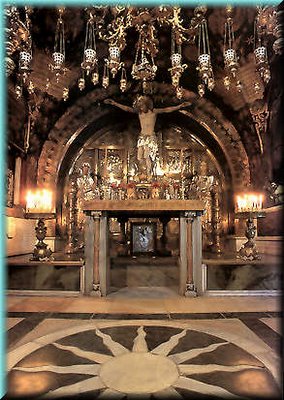
What I Saw In The Holy Land, 17
Although I am happy to have had the chance to affirm my faith in the midst of hissing and cursing, I'll be the first to admit my heart beat at a more comfortable pace once we were out of the Muslim Quarter (the first five stations of the cross are there). The remainder of the stations were uneventful for us --although we found later that six people were wounded in a "demonstration" that day, so while I'm glad for my experience, I am telling you to heed the warnings and stay away on Friday until after 2:00 pm. We carried the cross through the narrow streets until we came to the Church of the Holy Sepulchre, where the five final stations are.
I'll talk more about the Church itself in the next post. Here I am simply showing you Calvary. As at Bethelehem, you don't want it to look like this, right? I found the appearance a bit shocking the first time I saw it. But by the time we did the stations, I'd been to mass here about five times and had grown accustomed to it, so it was not difficult to peel away the ornament in my imagination and concentrate on where I was.
As you approach Calvary, you have to walk up a steep flight of stairs --it really is uphill-- and then the floor of the chapel is over Golgotha. Underneath the altar you see here is a silver star marking the spot it's thought the True Cross stood, and you kneel to reach your hand through an opening and touch the rock where it stood. A traveller's tip for you: no one seems to notice this, but if you go down the stairs from Calvary and head around to your right, you can actually stand at the foot of Golgotha looking up. It's not a perfect view, because a supporting wall of the old Crusader Church obstructs your view of where the cross was, but it does help your eyes to see what they want to see.
We actually didn't make it past Calvary in our stations, because an Orthodox sexton came through and hushed all the visitors, herding some of them out of the path of the priests who were on their way. Then a series of four Orthodox priests came in with thurifers to incense the altars and windows in the two chapels here (Calvary, and to the right is the Latin-rite chapel of Christ's being nailed to the cross). I couldn't distinguish which was which among the Greek, Armenian, Syrian or Coptic vestments, but that's what they were.
Among the most moving sights I saw here at Calvary was after an early mass our first morning in Jerusalem. One of our French companions was a late middle-aged woman with a bum hip and arthritis. She walked with difficulty with a cane, but at Calvary she knelt on the floor and "walked" to the spot on her knees. I watched her pray there, touching Golgotha for a long while, then kissing the stone before rising with great strain, yet equal dignity, to her feet again.

